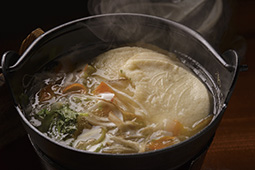INDEX

Cooling steamed rice in cold fresh air 
Kuji Kosuke (second right) receives the IWC’s Champion Sake of 2017 award 
Senbei-jiru, a local dish of Iwate Prefecture
March 2021
Sake from Iwate to the World

A sake brewery in Iwate Prefecture with a history surpassing 120 years is actively implementing new initiatives, expanding overseas sales channels and utilizing AI in the sake manufacturing process while preserving traditional sake production.

It is said that sake in the Nanbu domain (part of present-day Aomori and Iwate Prefectures) was first brewed in the early Edo period (1603–1867). The domain put effort into sake production as a policy of industrial development. In the winter, sake breweries in the domain hired farmers to produce sake during the agricultural off-season. In the world of sake production, the head brewer at the production site is known as the toji, and the group of head brewers from the Nanbu domain was known as the Nanbu Toji. Highly regarded for their reliable brewing techniques, the Nanbu Toji not only produced sake in their own domain but were invited to do so in other regions as well.
One of the sake breweries that has inherited the traditions and techniques of the Nanbu Toji is Nanbu Bijin Co. Ltd., founded in 1902 in Ninohe City at the northern tip of Iwate Prefecture. The company’s flagship sake brand is the eponymously named Nanbu Bijin (bijin means “beautiful woman”) and is known throughout Japan as one of Iwate’s representative sakes. Nanbu Bijin has won numerous national and international competitions, including Champion Sake of 2017, the highest award in the Sake category of the International Wine Challenge.*

According to Kuji Kosuke, fifth-generation head and president of the sake brewery, the company has pursued what it calls “authentic quality” since its founding, and this phrase has become its “family motto.” Kuji explains that the main ingredient of Nanbu Bijin is locally grown rice suitable for sake, which is carefully selected and polished to a ratio of at least 70% of its original grain size or, in the case of daiginjo-shu (super premium sake), to a grain polishing ratio of 50% or less. The water used for brewing is underground water from the Basenkyo Gorge (a part of the Oritsume Basenkyo Prefectural Natural Park) that springs from a well in the brewery. This mineralized, bluish water activates the yeast and koji (malted rice), giving Nanbu Bijin its flavor and body.
“The characteristics of our sake Nanbu Bijin are its fruity aroma and refreshing flavor, which make it hard to believe the sake is actually made from rice. Our goal is to make sake that brings a smile to everyone’s face the moment they taste it,” says Kuji.
While the company values the traditional sake production handed down by the toji, it has also actively pursued new initiatives. One such initiative was to expand overseas ahead of other breweries, beginning in 1997. Today, sake has fans all over the world, but at the time it was so little known outside Japan that Kuji did the rounds of restaurants, personally handing out bottles of his company’s sake. Thanks to those efforts and the subsequent boom in Japanese food, Nanbu Bijin now has sales channels in cities such as New York and London, and exports to thirty-nine countries around the world. It has become known abroad by the label “Southern Beauty,” a literal rendering of Nanbu Bijin. In 2018, the company was recognized by the Ministry of Agriculture, Forestry and Fisheries of the Japanese government as an outstanding exporter of Japanese agricultural, forestry and fishery products and foods.

In order to reach a wider customer base, the company has obtained vegan and kosher certification for its sake. And in recent years, it has been collaborating with an IT venture company on a project to convert part of the brewing process that relies on the experience and intuition of craftsmen into data through the use of AI.
Iwate Prefecture faces the Sanriku Coast, an area abundant in marine products (see Highlighting JAPAN May 2020 issue). Kuji says that Nanbu Bijin is exceptional when drunk with fresh local hokkigai (surf clams), oysters, and a local dish dating back to the Edo period called senbei-jiru, a stew of chicken, vegetables and another local specialty, nanbu-senbei rice crackers.

“The best way to drink not only sake but any kind of liquor is to feel the water, air and climate of the place where it was produced. When COVID-19 has been brought under control, I hope you will visit the north of Iwate and enjoy Nanbu Bijin along with local foods and specialties,” says Kuji with a big smile.
* The International Wine Challenge (IWC) is a major international wine competition held every year since 1984.

